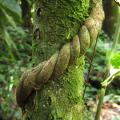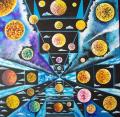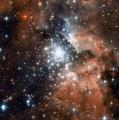
❤️🔥
 
Posts: 3648 Joined: 11-Mar-2017 Last visit: 17-Jan-2026 Location: 🌎
|
Published in nature today. https://www.nature.com/articles/s41598-019-45812-wIt's open access. Enjoy!
|
|
|
|
|

❤️🔥
 
Posts: 3648 Joined: 11-Mar-2017 Last visit: 17-Jan-2026 Location: 🌎
|
Here is an interesting snippet: Nature.com wrote:we show DMT levels are significantly elevated by experimentally-induced cardiac arrest
Isn't this strong scientific evidence that the DMT experience is related to near death experiences?
|
|
|

DMT-Nexus member

Posts: 2147 Joined: 09-May-2009 Last visit: 16-Jan-2026 Location: the shire, England
|
Fresh off the press study I thought it may be of interest to some Nexians. Study:Biosynthesis and Extracellular Concentrations of N,N-dimethyltryptamine (DMT) in Mammalian Brain Dean, J.G., Liu, T. Huff, S. Sheler, B. Barker, S.A. Strassman, R.J., Wang, M.M. & Borjigin, J. (2019) Biosynthesis and Extracellular Concentrations of N,N-dimethyltryptamine (DMT) in Mammalian Brain. Scientific Reports, 9, 9333. https://www.nature.com/a...GlCWvjqkP9kQPyroItneL2V0Quote:Abstract
N,N-dimethyltryptamine (DMT), a psychedelic compound identified endogenously in mammals, is biosynthesized by aromatic-L-amino acid decarboxylase (AADC) and indolethylamine-N-methyltransferase (INMT). Whether DMT is biosynthesized in the mammalian brain is unknown. We investigated brain expression of INMT transcript in rats and humans, co-expression of INMT and AADC mRNA in rat brain and periphery, and brain concentrations of DMT in rats. INMT transcripts were identified in the cerebral cortex, pineal gland, and choroid plexus of both rats and humans via in situ hybridization. Notably, INMT mRNA was colocalized with AADC transcript in rat brain tissues, in contrast to rat peripheral tissues where there existed little overlapping expression of INMT with AADC transcripts. Additionally, extracellular concentrations of DMT in the cerebral cortex of normal behaving rats, with or without the pineal gland, were similar to those of canonical monoamine neurotransmitters including serotonin. A significant increase of DMT levels in the rat visual cortex was observed following induction of experimental cardiac arrest, a finding independent of an intact pineal gland. These results show for the first time that the rat brain is capable of synthesizing and releasing DMT at concentrations comparable to known monoamine neurotransmitters and raise the possibility that this phenomenon may occur similarly in human brains.
Introduction
N,N-dimethyltryptamine (DMT) belongs to a class of serotonergic psychedelics that includes lysergic acid diethylamide (LSD) and psilocybin1. DMT, like all serotonergic psychedelics, reliably elicits a wide spectrum of subjective effects on brain functions including perception, affect, and cognition2. These compounds share structural and functional similarities with serotonin (5-hydroxytryptamine, 5-HT), and interact with 5-HT and other receptors to produce their effects3,4,5. Unlike other psychedelics, however, DMT is endogenously produced in animals6,7,8, including humans9,10,11. In addition to the subjective psychedelic effects exogenous administration of DMT has on conscious experience, it has other well-documented anti-hypoxic12, antidepressant13, and plasticity-promoting actions14. Taking these facts together, a further understanding of why DMT is present in mammals is of interest.
Biosynthesis of DMT from tryptamine requires double methylation reactions catalyzed by indolethylamine-N-methyltransferase (INMT)15,16. INMT mRNA was identified at high levels in peripheral tissues in rabbits17 and in humans18. However, this peripheral INMT also methylates other ligands such as histamine17,19. In the brain, INMT mRNA was found at very low levels in rabbits17 and was undetectable in humans18. No study to date has yet identified INMT in the cerebral cortex in any species. In addition to INMT, production of DMT requires aromatic-L-amino acid decarboxylase (AADC), which removes the carboxyl group from dietary tryptophan to form tryptamine, the essential DMT precursor that can be rapidly metabolized by monoamine oxidase20. While high levels of INMT mRNA expression in the periphery17,18 have been assumed to indicate the potential for correspondingly high levels of DMT, cellular colocalization of INMT and AADC transcripts has not yet been reported in any tissue. Moreover, studies to date assessing levels of DMT in human peripheral bodily fluids have only reported it in trace amounts11, calling into question any physiological role.
In order to address some of these issues, this study examined expression of INMT mRNA in rat and human brain tissues using in situ hybridization. In addition, we conducted double in situ hybridization studies to probe the co-expression of INMT and AADC mRNA in rat brain and periphery. To investigate the presence of DMT in rat brain, we analyzed DMT content in microdialysis samples collected directly from the visual cortices of living pineal-intact and pinealectomized rats. Pinealectomized animals were studied because previous data established the presence of DMT in living rat pineal dialysate8. To investigate whether DMT brain levels are inducible by physiological alterations, we assessed its levels in rat brain following cardiac arrest with or without the pineal gland, as a prior study from our lab demonstrated a surge in the levels of select neurotransmitters in rat visual cortex following cardiac arrest using this technique21.
...
Discussion
We report [1] cortical expression of INMT mRNA in rat and human brain, [2] colocalization of INMT and AADC mRNA in the same cells in rat brain, and [3] predominately non-overlapping expression of INMT with AADC mRNA in rat peripheral organs including the adrenal, kidney, lung, and heart. We further show that DMT is present in rat visual cortex in pineal-intact and pinealectomized animals. Moreover, we show DMT levels are significantly elevated by experimentally-induced cardiac arrest. Collectively, these data support the notion that DMT is synthesized in rat brain and at concentrations consistent with that of other known monoamine neurotransmitters. Our demonstration of INMT mRNA expression in human cerebral cortex, choroid plexus, and pineal gland also suggest that DMT biosynthesis may similarly occur in the human brain.
This study demonstrates for the first time that INMT mRNA, the transcript for a key DMT synthetic enzyme, is widely expressed in the cerebral cortex in rats. Importantly, INMT and AADC transcripts are co-expressed in the same brain cells, providing a plausible mechanism for cellular synthesis of DMT in the mammalian neocortex. DMT is a monoamine produced from tryptophan. If endogenous DMT functions as a non-classical monoamine neurotransmitter in the brain, DMT would be the only monoamine whose biosynthesis takes place within the cerebral cortex where it may directly influence cognitive functions of the brain.
While AADC expression in the brain is well known26, INMT expression in the brain was unclear prior to our study. Earlier studies showed that INMT mRNA was only weakly present in rabbit brain tissues17, and undetectable in human brain tissues18. These prior reports are all based on Northern blot analysis, which provides no information on cellular distribution of INMT mRNA and is less sensitive compared to quantitative polymerase chain reaction or the in situ hybridization method used in our study. We were able to identify INMT mRNA in both rat and human brain tissues using the RNAscope in situ assay system, in part because of the high sensitivity afforded by this technique27, which allowed robust and unambiguous identification of INMT mRNA in both rat and human brain FFPE tissues for the first time (see Fig. 1).
AADC is best characterized as one of the enzymes necessary for the synthesis of all canonical monoamine neurotransmitters, including 5-HT [together with tryptophan hydroxylase (TPH)] and dopamine/norepinephrine [together with tyrosine hydroxylase (TH)]. In the pineal gland, AADC (together with TPH) is well known to mediate the synthesis of 5-HT, the precursor for melatonin production28. In the brain, AADC mRNA is present abundantly in the monoamine neurons in the brainstem26. However, AADC mRNA and protein have also been reported in neurons of the cerebral cortex and hippocampus26 that do not contain TH/TPH in mice, rats and humans29,30,31,32,33. To date, the function of these AADC-positive and TH/TPH-negative neurons is unknown.
Using the RNAscope in situ hybridization technique, we identified AADC mRNA in several regions of the rat brain (Fig. 2), including the cerebral cortex and hippocampus (Fig. 2), consistent with what has been reported in mouse brain26. Critically, we found in each of these rat structures that AADC mRNA is colocalized with an INMT transcript (Fig. 2), suggesting that these INMT-positive and AADC-positive neurons may function as DMT-producing neurons (or D-neurons) and that DMT, a non-canonical monoamine, may possibly be the principle neurotransmitter in these widely distributed brain D-neurons. A functional role of the D-neurons will need to be explored in future studies. For example, INMT-deficient animals are necessary to demonstrate unequivocally that INMT is responsible for the endogenous production of DMT.
INMT protein was also found in monkey pineal gland in a prior study34. Our study expanded this finding and demonstrated an abundant expression of INMT mRNA in the pineal gland in both rats and humans (Fig. 1). Co-expression of INMT and AADC mRNA in rat pinealocytes was confirmed by double in situ hybridization analysis (Fig. 2), suggesting that a potential mechanism for DMT biosynthesis, as in the rat visual cortex, exists in the pineal gland. Transcripts for DMT synthetic enzymes were detected additionally in the choroid plexus, a venous network lining the ventricles of the brain that produce CSF, a fluid in which DMT has been detected11. The choroid plexus contains a high density of 5-HT2C receptors whose stimulation by agonists leads to marked reduction of CSF production35. As DMT is an agonist at the 5-HT2C receptor4,5,36 and LSD binds to the 5-HT2C receptor in cultured choroid plexus epithelial cells to stimulate their activity37, the effect of endogenous DMT on CSF regulation deserves additional investigation.
The high levels of INMT mRNA previously found in peripheral tissues18 have led to speculation that DMT is released from peripheral stores and subsequently transported to the brain. Consistent with earlier Northern blot analysis of human tissues18, we found high levels of INMT mRNA expression in rat kidney, lung, heart, and adrenal (Fig. 3). However, INMT mRNA expression in rat peripheral tissues showed very limited overlap with AADC mRNA at the cellular level, suggesting that INMT may have functions independent of DMT synthesis in the periphery. Although our present data suggest that DMT in the brain does not originate from peripheral sources but, rather, is produced locally in specific brain tissues, future studies (using brain-specific INMT knockout animals, for example) could be conducted to conclusively demonstrate that DMT found in brain dialysates originates from the brain. Peripheral INMT may be responsible for established DMT-independent functions such as methylation of sulfur-containing compounds38, histamine17,19, and selenium metabolism39.
DMT is an endogenous monoamine whose physiological functions remain unknown. Furthermore, since exogenous DMT can bind with nanomolar affinities to various receptors including 5-HT receptors40,41,42,43 and trace-amine associated receptors (reviewed in ref.44), endogenous DMT may influence brain functions via the same receptors. If DMT were indeed to function as a non-canonical monoamine neurotransmitter, however, it must be present in the brain at a physiologically relevant concentration. Presence of DMT has been reported in various species including rats6,7,8,9,10,11, yet its in vivo concentration in living brain has not been reported. This study represents the first quantification of DMT in the extracellular fluid of the brain in freely moving and normal behaving animals.
The baseline concentration of DMT in cortical microdialysates ranged between 0.05 to 1.8 nM (blue dots in Fig. 4Ab) in pineal-intact rats, and between 0.25 to 2.2 nM (blue dots in Fig. 4Bb) in pinealectomized rats. DMT levels showed no significant difference between rats with the pineal and without the pineal gland (Fig. 4Ca). Importantly, this cortical concentration of DMT (average 1.02 nM) is only slightly lower than that of 5-HT detected in the same dialysates, which averaged around 2 nM in rats without the pineal gland (Fig. 4Cc). This value of 5-HT in brain dialysates is consistent with what others have found in rats (average 0.87 nM; 0.12–3.4 nM range) [reviewed in ref.25]. In fact, the basal DMT concentrations (Fig. 4Ab; average 1.02 nM; 0.25–2.2 nM range) in the brain microdialysates are well within the known range of all three canonical monoamine neurotransmitters25: 5-HT (average 0.87 nM; 0.12–3.4 nM range), norepinephrine (average 1.77 nM; 0.19–4.4 nM range), and dopamine (average 1.5 nM; 0.07–4.9 nM range). We wish to emphasize that our microdialysates were collected and analyzed online in real time from rats without any pretreatment to block the activity of monoamine oxidase, an enzyme that rapidly degrades DMT in vivo15,45. The mechanism and function of cortical DMT production remain to be fully investigated.
DMT was previously detected in freely moving rats8. However, DMT was not quantified in that study. Furthermore, the microdialysates used for DMT analysis8 were collected from both the pineal gland and the surrounding visual cortex of rats and it was unclear whether the detected DMT was from the pineal alone, the cortex alone, or both. To address this latter issue, we surgically removed the pineal gland and monitored DMT levels in rats both under baseline and following cardiac arrest (Fig. 4B). We found that DMT concentrations in the brain are independent of the pineal gland, as cortical DMT levels show no significant difference with or without the pineal gland (Fig. 4Ca). These data suggest that the cortex may be one of the major sources of released DMT from the brain. At this point, it is uncertain to what extent, if any, the pineal contributes to DMT production8. It is also unclear whether DMT detected in the brain extracellular fluid is secreted from neurons and/or glial cells. Colocalization studies using both an INMT probe and cell-type specific markers should be used in future studies to clarify this.
The extensive colocalization of INMT and AADC transcripts in pinealocytes (Fig. 2C), and the apparent lack of the pineal’s contribution to the brain production of DMT (Fig. 4Ca) present a paradox. We reasoned that there may be two competing pathways for tryptophan in the pineal: (1) conversion of tryptophan to 5-HT via sequential actions of TPH and AADC, and (2) the potential conversion of tryptophan to DMT via sequential actions of AADC and INMT. It is plausible that in the pineal, the first pathway is overwhelmingly dominant, resulting in high production of 5-HT at the expense of DMT. The established properties of the enzymes support this: the affinity of tryptophan for TPH (Km = 41.3 uM)46 in the 5-HT/melatonin synthesis pathway is substantially higher compared to the reported affinity of tryptophan for AADC (Km = 3000 uM)47 in the DMT biosynthetic pathway. Thus, if the same cell expresses both TPH and AADC, tryptophan will be more likely to be converted to 5-hydroxytryptophyan (destined to 5-HT) than to tryptamine (destined to DMT). Additionally, 5-hydroxytryptophan binds to AADC with substantially higher affinity than tryptophan (Km = 160 uM48 versus Km = 3000 uM)47. As a result, high levels of 5-hydroxytryptophan found in the pineal are likely to competitively inhibit AADC conversion of tryptophan to tryptamine, further reducing this intermediate in DMT production. The relatively low affinity of AADC for tryptophan thus reduces the production of DMT in pineal cells that contain both TPH and AADC. These data may explain the possibility that the pineal gland contributes little to DMT production, despite the abundant co-expression of AADC and INMT in the pinealocytes. We could not, however, rule out the possibility that there may be compensatory increases in DMT’s biosynthesis in other brain areas following the loss of the pineal gland.
In our previous studies, we have observed a marked elevation of some, but not all, critical neurotransmitters in rat brain during asphyxic cardiac arrest21, which we posit may contribute to the elevated conscious information processing observed in dying rats21,49. These data also suggest that global ischemia (by cardiac arrest, as in the current study), similar to global hypoxia (by asphyxia, as in21), leads to a tightly regulated release of a select set of neurotransmitters21. To test whether DMT concentrations are regulated by physiological alterations, we monitored DMT levels in rat brain dialysates following experimentally-induced cardiac arrest, and identified a significant rise in DMT levels in animals with (Fig. 4A) and without the pineal (Fig. 4B).
The cardiac arrest-induced increase of endogenous DMT release may be related to near-death experiences (NDEs), as a recent study reports NDE-like mental states in human subjects given exogenous DMT50. Not all rats in our current study exhibited a surge of DMT following cardiac arrest (Fig. 4), an interesting observation in light of the fact that NDEs are reported by less than 20% of patients who survive cardiac arrests51. It is unknown whether the concentrations of DMT reported in our study at cardiac arrest can elicit the effects of an exogenous psychedelic dose of DMT, or whether this surge of endogenous DMT similarly occurs in humans. Moreover, the conscious states reported by NDE survivors may involve contributions from several of the other neurotransmitters found to surge at cardiac arrest in our prior rodent study21. Further investigation is clearly warranted to investigate whether DMT plays a role in generating neural correlates of near-death consciousness.
In conclusion, we present evidence for the brain expression of mRNA for INMT, the key DMT synthetic enzyme previously thought to exist only in the periphery, and demonstrate that, unlike in the periphery, transcripts for the DMT synthetic enzymes AADC and INMT are co-expressed in the same cells within the rat brain. The wide co-expression of transcripts for the DMT synthetic enzymes in the rat brain and basal concentrations of DMT comparable to that of other monoamine neurotransmitters indicate that endogenous DMT may influence brain function.
...
|
|
|

DMT-Nexus member
Posts: 1111 Joined: 18-Feb-2017 Last visit: 12-Jul-2024
|
Thanks, I just saw this article: https://medicalxpress.co...lic-compound-brains.html , which is about the same study.
|
|
|

ⁿ°ⁿ↔ρ└ªγ³r κhªrªκτ³r
Posts: 337 Joined: 19-Aug-2018 Last visit: 29-Jun-2019
|
Loveall wrote:Here is an interesting snippet: Nature.com wrote:we show DMT levels are significantly elevated by experimentally-induced cardiac arrest
Isn't this strong scientific evidence that the DMT experience is related to near death experiences? It very well may be.
|
|
|

Dreamoar

Posts: 4711 Joined: 10-Sep-2009 Last visit: 16-Jan-2026 Location: Rocky mountain high
|
The researchers were very careful to qualify it: Quote:Not all rats in our current study exhibited a surge of DMT following cardiac arrest (Fig. 4), an interesting observation in light of the fact that NDEs are reported by less than 20% of patients who survive cardiac arrests51. It is unknown whether the concentrations of DMT reported in our study at cardiac arrest can elicit the effects of an exogenous psychedelic dose of DMT, or whether this surge of endogenous DMT similarly occurs in humans. Moreover, the conscious states reported by NDE survivors may involve contributions from several of the other neurotransmitters found to surge at cardiac arrest in our prior rodent study21 I think the biggest finding here, at least in my eyes, is that DMT is part of the every day biochemical cocktail that runs the mammalian wetware. If it's floating around in quantities on par with serotonin, which is exactly what this study says is happening, what does that say about our coveted serotonin<->mood<->behavior paradigm? Maybe it's time for some Selective Dimethyltryptamine Reuptake Inhibitors.  The fact they used pineal knockout mice, and that the pinealectomy didn't really seem to effect DMT concentrations, both pre and post mortem, is quite interesting. Looks like we need to switch our pineal bar for a cortex bar. I'm immensely pleased to see some of long lingering questions finally being conclusively addressed and I'm excited for possible new avenues of research this opens up.
|
|
|

analytical chemist
   
Posts: 7463 Joined: 21-May-2008 Last visit: 09-Aug-2025 Location: the lab
|
0_o wrote:Loveall wrote:Here is an interesting snippet: Nature.com wrote:we show DMT levels are significantly elevated by experimentally-induced cardiac arrest
Isn't this strong scientific evidence that the DMT experience is related to near death experiences? It very well may be. It's stronger evidence for the stress model of biosysnthesis, which also suggested production in the peripheral tissues. I believe this was covered in Thompson et. al, 1999, and reviewed in Presti et. al 2004. "Nothing is true, everything is permitted." ~ hassan i sabbah
"Experiments are the only means of attaining knowledge at our disposal. The rest is poetry, imagination." -Max Planck
|
|
|

❤️🔥
 
Posts: 3648 Joined: 11-Mar-2017 Last visit: 17-Jan-2026 Location: 🌎
|
For what it's worth, they mentioned up to 5nM DMT concentration levels post cardiac arrest in rats. That's about 1ng/ml I believe. In humans it's been reported that in the DMT space brain concentration is above 60ng/ml (see below for more details). Loveall attached the following image(s):  fphar-07-00211-g003.jpg (137kb) downloaded 299 time(s).
|
|
|
DMT-Nexus member
Posts: 660 Joined: 30-Jul-2016 Last visit: 15-Jul-2019 Location: Europe
|
Loveall wrote:Here is an interesting snippet: Nature.com wrote:we show DMT levels are significantly elevated by experimentally-induced cardiac arrest
Isn't this strong scientific evidence that the DMT experience is related to near death experiences? No. At most it doubled the DMT concentration due to this, but which still is way too small to have any significant effect in this relation. Also from my personal NDE experience, I would say it is clearly NOT DMT that is acting there. Very very different effect wise. But what I find really interesting is the finding that the pineal gland really doesn't seem to play any significant role in the DMT production. Also that DMT at least in rats does seem to occur in a concentration that it might show psychoactive effects (e.g. on the mood). I claim not that this is the truth. As this is just what got manifested into my mind at the current position in time on this physical plane. So please feel not offended by anything I say.
|
|
|

ⁿ°ⁿ↔ρ└ªγ³r κhªrªκτ³r
Posts: 337 Joined: 19-Aug-2018 Last visit: 29-Jun-2019
|
The stress model Benzyme mentions fits quite well.
What other simple tryptamines or betacarbolines were elevated similarly?
|
|
|

❤️🔥
 
Posts: 3648 Joined: 11-Mar-2017 Last visit: 17-Jan-2026 Location: 🌎
|
Aum_Shanti wrote:Loveall wrote:Here is an interesting snippet: Nature.com wrote:we show DMT levels are significantly elevated by experimentally-induced cardiac arrest
Isn't this strong scientific evidence that the DMT experience is related to near death experiences? No. At most it doubled the DMT concentration due to this, but which still is way too small to have any significant effect in this relation. Also from my personal NDE experience, I would say it is clearly NOT DMT that is acting there. Very very different effect wise. But what I find really interesting is the finding that the pineal gland really doesn't seem to play any significant role in the DMT production. Also that DMT at least in rats does seem to occur in a concentration that it might show psychoactive effects (e.g. on the mood). Agreed. I was trying to explain on post #6 that the boost seems small - an order of magnitude below psychedelic trip effects if (in a gross estimate) one compares rat and human concentrations (a few nM post stroke vs 60+ nM during psychedelic trips). I'm curious about your NDE experience if you don't mind talking about it. Would you describe it as psychedelics? Did it seem related or similar to any other psychedelics? Since the DMT boost alone does not seem sufficient, in chat we were wondering if a mix of neurotransmitters may be involved (including speculations of 5MEO). The stress model makes sense, but maybe it's not the only thing going on (or maybe it is).
|
|
|
DMT-Nexus member
Posts: 660 Joined: 30-Jul-2016 Last visit: 15-Jul-2019 Location: Europe
|
Loveall wrote:
I'm curious about your NDE experience if you don't mind talking about it.
First I maybe have to mention, that I almost drowned when I was a little child, as the type of deadly ending may have an influence on the experience... Quote:
Would you describe it as psychedelics? Did it seem related or similar to any other psychedelics?
Not really in the sense, that it was like a typical psychedelic trip. E.g. there were no visual distortions at all (morphs/patterns, you name it...). Also I had like zero mindfuck. It was a fight for physical survival (trying to get to the water surface), until I accepted to die, then suddenly everything got totally silent, and I got a feeling of total peace, then there started to be this bright light from above, where I was drawn to... Quote: Since the DMT boost alone does not seem sufficient, in chat we were wondering if a mix of neurotransmitters may be involved (including speculations of 5MEO). As said, at least IMHO DMT plays zero role in this relation, due to the absence of any visual or sound effects. Also the mindspace was completely different. If I'm honest, I would rather assume, there's probably mostly a kind of body opioid at work here. But the light and later part was actually very similar to some ego-deaths I had on various psychedelics (e.g. shrooms or 5-MeO-DMT). But I had no bodyload at all whatsoever. On 5-MeO-DMT I have a terrible bodyload prior to full-release, which I didn't have. Actually if I think about it, maybe a combination of an opioid together with 5-MeO-DMT might result in a similar experience??? I don't know. I claim not that this is the truth. As this is just what got manifested into my mind at the current position in time on this physical plane. So please feel not offended by anything I say.
|
|
|

❤️🔥
 
Posts: 3648 Joined: 11-Mar-2017 Last visit: 17-Jan-2026 Location: 🌎
|
Thank you Aum_Shanti, that is very interesting.
|
|
|

DMT-Nexus member
Posts: 88 Joined: 23-May-2012 Last visit: 08-Jul-2019 Location: California
|
Wow, very fascinating! I've always had reservations about the hypothesis that DMT is endogenously produced in humans, but this is quite cogent empirical evidence. Obviously, the two further big questions are whether or not DMT is endogenously produced under certain circumstances in quantities that cause apparently psychedelic effects, and whether or not this may have any relevance to near-death experiences (NDE). Personally, I think there are some considerations against DMT and NDE connection, that are not apparent in the Nature article or this thread. First of all, Borjigin and colleagues (2013) had advanced the hypothesis that NDEs are causally related to a surge of activity in the dying brain prior to the present discovery of DMT in rat and human brain tissue. (Similarly, Borjigin's 2013 study was based on measurements taken in rats undergoing induced cardiac arrest.) So, the idea that DMT is relevant to NDEs is contingent upon the broader hypothesis advanced by Borjigin et al. that a surge of electrical activity concomitant with a dump of a potent neurochemical cocktail occurs circa death. However, there are, in my opinion, several reasons that this hypothesis alone cannot account for the NDE phenomena as a whole. Researchers at the Department of Psychiatry and Neurobehavioral Sciences, University of Virginia, published a brief but rather definitive rebuttal of Borjigin's 2013 paper where they enumerated seven reasons why Borjigin's hypothesis is inadequate. I'll link the paper below. Some of their reasons include, e.g., the fact that NDEs occur under deep general anesthesia in which brain activity is disrupted and suppressed but in which there is no hypoxia (lack of blood flow, e.g., due to cardiac arrest) in the brain; and that numerous experimental and case studies which have investigated the neurophysiological correlates of cardiac arrest in humans (and other animals well, such as apes and dogs) have demonstrated no such surge of electrical activity - rather, they have by and large found that the EEG rapidly attenuates and progresses to isoelectricity (flat EEG) within 10-20 seconds. I can also think of another reason not explicitly mentioned by the researchers in their response paper to Borjigin: the fact that certain NDE cases have occurred under close physiological monitoring and no such surges were observed. Thus, even if the surge of electrical activity postulated by Borjigin might be relevant for some NDEs, it is clearly not necessary for them to occur. Secondly, I don't find the phenomenology of NDEs and DMT experiences to be very similar overall. Yes, there is overlap in certain areas due to the fact that they both would classify as "transpersonal" or "mystical" or transcendent "visionary" experiences, but specific aspects of their respective phenomenologies are very different. Again, I will attach a published paper below that directly compares NDEs and DMT experiences. I don't agree with everything in the paper (in fact, I think NDEs and DMT experiences are less dissimilar than the author makes them out to be) - but it's a good start. I think we need to be very sensitive to the phenomenological typology of these altered states, and not be so quick to lump disparate domains together in accordance with our favorite theory. A good way to avoid doing that is to really familiarize oneself with several first-hand accounts from each domain, and compare them side-by-side - all the while realizing the limitations of language, as well as one's own biases to draw connections where none may be present. It's also important to note that popular science articles rarely if ever situate the new findings that they are reporting on in the context of all the relevant data that has come beforehand (plus, many of these articles contain blatant inaccuracies).
|
|
|

DMT-Nexus member
Posts: 353 Joined: 05-Jun-2019 Last visit: 23-Oct-2023 Location: nammyohorenghekyo
|
I could be wrong, but I thought the whole death/DMT thing was actually due to the release of Pinoline which potentiated endogenous tryptamines, but if the rats had their pineal gland removed then that's probably bunk. I've always felt like consciousness itself is a psychedelic experience, one that we are so accustomed to that we tend to discard or overlook the fact that serotonin and melatonin are tryptamines themselves. DMT is fascinating, but it isn't the only ring (indole) in the circus. Author of this Post assumes no Responsibility, nor makes any Guarantee of the Accuracy or Validity of material in this Post. Material Contained or referred to in this Post is presented for Entertainment Purposes Only. This Material IS Not Intended to be Inferred, or Interpreted as Information, Advice, News, Instruction, or Factual Information.
|
|
|

DMT-Nexus member
Posts: 1111 Joined: 18-Feb-2017 Last visit: 12-Jul-2024
|
One question that comes to mind...
Many report Caapi to be psychoactive on its own and produce visions. I wonder if at least part of this effect may be due to the slowing down of the breakdown of endogenous DMT by the harmalas, leading to an increased concentration of DMT (and potentially other endogenous amines, like melatonin, which might promote hypnagogia or related faintly visionary states)?
On occasion, when bioassaying my extracts (to determine DMT content) orally, with harmalas, I find it hard to tell if I'm feeling faint DMT effects from the extract or it's the harmalas. Could it be endogeous DMT made more obvious by the harmalas?
|
|
|

DMT-Nexus member
Posts: 218 Joined: 09-Jul-2016 Last visit: 03-Jul-2025
|
Jagube wrote:One question that comes to mind...
Many report Caapi to be psychoactive on its own and produce visions. I wonder if at least part of this effect may be due to the slowing down of the breakdown of endogenous DMT by the harmalas, leading to an increased concentration of DMT (and potentially other endogenous amines, like melatonin, which might promote hypnagogia or related faintly visionary states)?
On occasion, when bioassaying my extracts (to determine DMT content) orally, with harmalas, I find it hard to tell if I'm feeling faint DMT effects from the extract or it's the harmalas. Could it be endogeous DMT made more obvious by the harmalas? It does seem that way now there are more evidences out. And suppose that is the case, then the next consideration would be by what methods can someone induce large amount of self-generated DMT within the brain/body.... I also wonder if MAOI stops the breakdown of more compounds than just dmt.
|
|
|

DMT-Nexus member
  
Posts: 3555 Joined: 13-Mar-2008 Last visit: 07-Jul-2024 Location: not here
|
Quote:I also wonder if MAOI stops the breakdown of more compounds than just dmt. Yes they do, although it depends which MAO is being inhibited. MAO enzymes break down more then just dmt also serotonin, epinephrine, dopamine, etc.
|
|
|

I rather root my values in my own hallucinations than in society´s neurotic illusions..
Posts: 681 Joined: 08-Jul-2017 Last visit: 08-Jul-2020 Location: Barcelona
|
Very fascinating post! And thanks for sharing your NDE Aum Shanti.. Shanti Shanti... Very interesting! Very very... You have to remember also guys that even if the concentration of DMT at the cardiac arrest is to low to produce a Psychadelic trip in comparison, I think we would react very differently if the body is about to die for real haha.. Probably a little more sensitive to these compounds when the body is about to chek out for good!  And as someone mentioned the 5 MEO seems to play a big part as well.. Have anyone tried to smoke them together at the same time??? "Too cute to live, too cozy to die" - Eaglepath
|
|
|

Kalt und Heiß, Schwarz und Rot, Kürper und Geist, Liebe und Chaos
 
Posts: 4661 Joined: 02-Jun-2008 Last visit: 30-Apr-2022
|
For the record, it is Scientific reports, not Nature. There is a big difference in terms of Impact Factor rating of the two journals. Scientific reports is owned by a Nature Publishing Group, but is still waaaay far from Nature Journal. Sci-rep is a bit of a run-of-the mill journal. Overall OK-ish study, of course their co-localisation experiments are a tad silly and fairly open to all sorts of interpretations. Sadly, the most interesting result i.e. the DMT increase after cardiac arrest do not live up to its name. Their cardiac arrest protocol is not described in the Methods (or linked refences) in any sort of detail, which of course leaves their interpretations up in the air. Still seems to be that the authors want to pander on the good ol' DMT-and-NDE link. But hey, better have their data out than not. But re any progress in the field? I wouldn't hold my breath. Need to calculate between salts and freebases? Click here! Need to calculate freebase or salt percentage at a given pH? Click here!
|